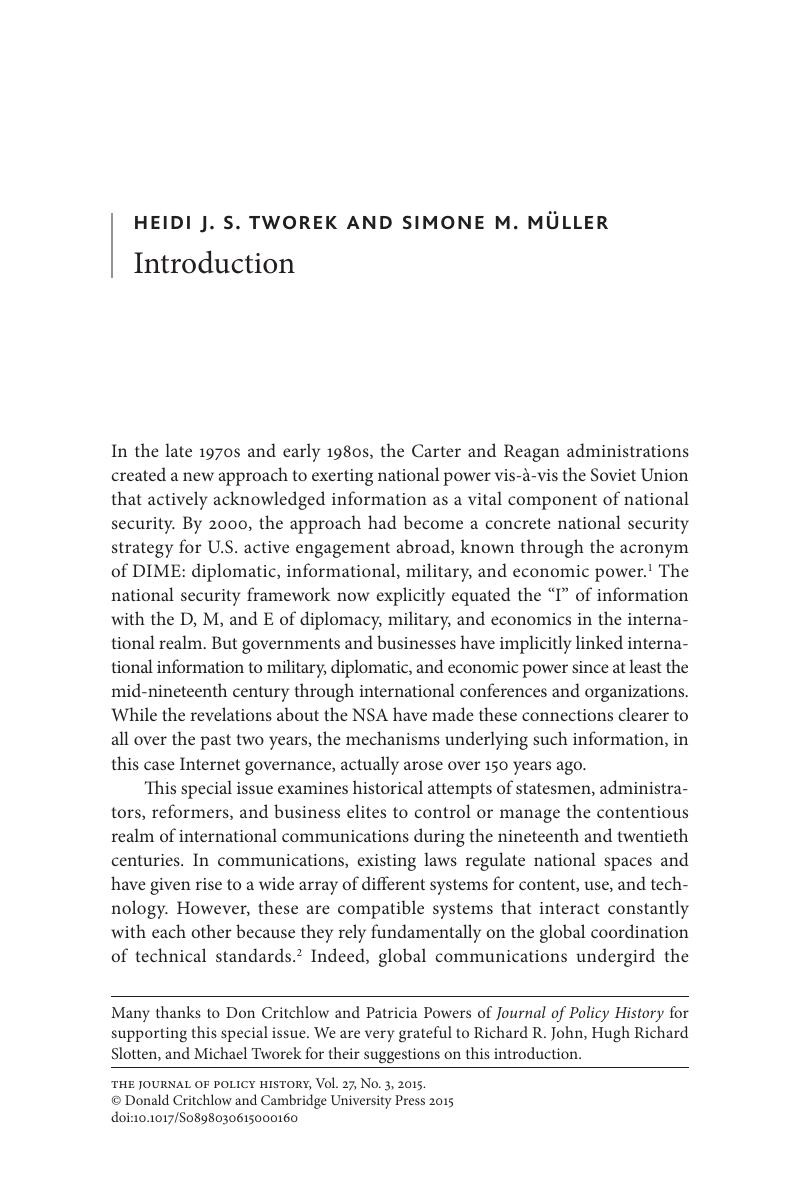Article contents
Introduction
Published online by Cambridge University Press: 09 June 2015
Abstract

- Type
- Articles
- Information
- Copyright
- Copyright © Donald Critchlow and Cambridge University Press 2015
Footnotes
Many thanks to Don Critchlow and Patricia Powers of Journal of Policy History for supporting this special issue. We are very grateful to Richard R. John, Hugh Richard Slotten, and Michael Tworek for their suggestions on this introduction.
References
NOTES
1. National Security Council, Presidential Directive/NSC-18 (24 August 1977), www.jimmycarterlibrary.gov/documents/pddirectives/pres_directive.phtml; National Security Council, National Security Decision Directive 32 (20 May 1982), www.reagan.utexas.edu/archives/reference/NSDDs.html#.VDMD-ce7kjU, both accessed 6 October 2014; Department of Defense, JFSC Pub 1, The Joint Staff Officer’s Guide 2000, National Defense University, Joint Forces Staff College, 2–11, www.uscg.mil/directives/cim/3000-3999/cim_3020_15d.pdf, accessed 7 October 2014.
2. On technical standards, see Brunsson, Nils and Jacobsson, Bengt, A World of Standards (New York, 2000)Google Scholar; Murphy, Craig N. and Yates, JoAnne, The International Organization for Standardization (ISO): Global Governance Through Voluntary Consensus (London, 2009)CrossRefGoogle Scholar; Richard Slotten, Hugh, “The International Telecommunications Union, Space Radio Communications, and U.S. Cold War Diplomacy, 1957–1963,” Diplomatic History 37 (2013): 313–71CrossRefGoogle Scholar; Schueler, Judith and Fickers, Andreas, eds., Bargaining Norms, Arguing Standards: Negotiating Technical Standards (The Hague, 2008)Google Scholar; Timmermans, Stefan and Epstein, Steven, “A World of Standards but Not a Standard World: Toward a Sociology of Standards and Standardization,” Annual Review of Sociology 36 (2010): 69–89.CrossRefGoogle Scholar
3. Singh Grewal, David, Network Power: The Social Dynamics of Globalization (New Haven, 2008), 10.Google Scholar
4. Thomas G. Weiss, “The UN’s Role in Global Governance,” UN Intellectual History Project Briefing Note Number 15 (August 2009), 1–2, http://www.unhistory.org/briefing/15GlobalGov.pdf.
5. For the distinction between coordination and regulation, see Holznagel, Bernd and Werle, Raymund, “Sectors and Strategies of Global Communications Regulation,” Knowledge, Technology, and Policy 17, no. 2 (2004): 19–37.CrossRefGoogle Scholar On the national regulation of American and German telecommunications, see Schulz, Günther, Schomeckel, Mathias, and Hausman, William J., eds., Regulation Between Legal Norms and Economic Reality. Intentions, Effects, and Adaptation: The German and American Experiences (Tübingen, 2014).Google Scholar For an STS perspective on standardization using the examples of fax, videotext, and message handling, see Schmidt, Susanne and Werle, Raymund, Coordinating Technology: Studies in the International Standardization of Telecommunications (Cambridge, Mass., 1998).Google Scholar
6. For an overview history, see Lyall, Francis, International Communications: The International Telecommunication Union and the Universal Postal Union (Burlington, Vt., 2011).Google Scholar On the ITU, see Laborie, Léonard, L’Europe mise en réseaux: La France et la coopération internationale dans les postes et les télécommunications (années 1850–années 1950) (Brussels, 2011).CrossRefGoogle Scholar
7. Many Voices, One World: Toward a New, More Just, and More Efficient World Information and Communication Order (New York, 1980). In protest at what they saw as UNESCO’s increasing politicization, Britain and the United States withdrew from UNESCO in 1984 and 1985, but rejoined in 1997 and 2003, respectively.
8. On the concept of open standards, see Russell, Andrew L., Open Standards and the Digital Age: History, Ideology, and Networks (New York, 2014). Thanks to Francine McKenzie for information on GATT.CrossRefGoogle Scholar
9. Law is a form of behavior standard. On the distinction between technical and behavior standards, see David, Paul A., “New Standards for the Economics of Standardization in the Information Age,” in Economic Policy and Technological Performance, ed. Dasgupta, Partha and Stoneman, Paul (Cambridge, 1987), 206–39.CrossRefGoogle Scholar On international law, see Koskenniemi, Martti, The Gentle Civilizer of Nations: The Rise and Fall of International Law, 1870–1960 (Cambridge, 2001).CrossRefGoogle Scholar
10. On the importance of national political regimes for international telecommunications, see Cowhey, Peter, “The International Telecommunications Regime: The Political Roots of Regimes for High Technology,” International Organization 44, no. 2 (1990): 169–99.CrossRefGoogle Scholar
11. Winseck, Dwayne R. and Pike, Robert M., Communication and Empire: Media, Markets, and Globalization, 1860–1930 (Durham, 2007).CrossRefGoogle Scholar On the intersection between capitalism and communications, see the special issue “Communicating Global Capitalism,” ed. Tworek, Heidi J. S. and Müller, Simone M., in Journal of Global History 10, no. 2 (2015).Google Scholar
12. Bently, Lionel, “Copyright, Translations, and Relations Between Britain and India in the Nineteenth and Early Twentieth Centuries,” Chicago-Kent Law Review 82 (2007): 1181–1240.Google Scholar
13. On the telephone, see John, Richard R., Network Nation: Inventing American Telecommunications (Cambridge, Mass., 2010).CrossRefGoogle Scholar On TAT cables, see Reed Winkler, Jonathan, “Bridging the Gap: The Cable and Its Challengers, 1918–1988,” in Communication Under the Seas: The Evolving Cable Network and Its Implications, ed. Finn, Bernard and Yang, Daqing (Cambridge, Mass., 2009), 25–44.CrossRefGoogle Scholar
14. Cortada, James W., “When Knowledge Transfer Goes Global: How People and Organizations Learned About Information Technology, 1945–1970,” Enterprise & Society 15, no. 1 (2014): 68–102.CrossRefGoogle Scholar
15. For concerns about Internet governance in both authoritarian regimes and democracies, see MacKinnon, Rebecca, Consent of the Networked: The Worldwide Struggle for Internet Freedom (New York, 2012)Google Scholar; Morozov, Evgeny, The Net Delusion: The Dark Side of Internet Freedom (New York, 2011).Google Scholar
16. On “constitutive choices” in media, see Starr, Paul, The Creation of the Media: Political Origins of Modern Communications (New York, 2004), 5–7.Google Scholar
- 1
- Cited by


